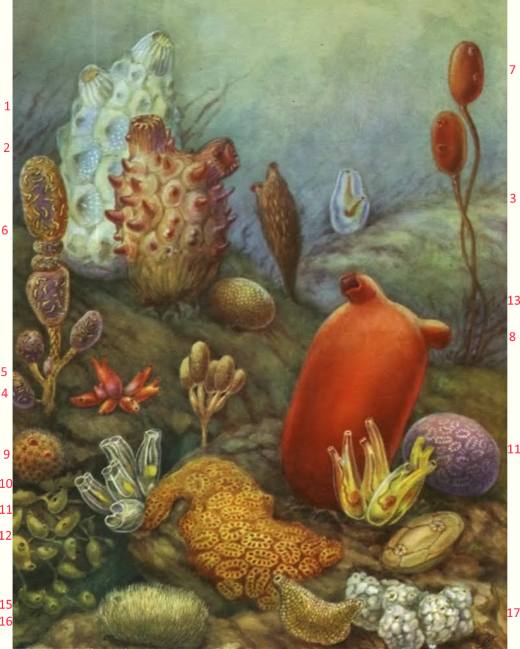star ascidian
.
star ascidian anatomy
The star ascidian can easely be distinguished from orther ascidia's: There are about 8 zooids that emanate from a center in the manner of the arms of a star. This tunicate comes in many colors like brown orange and yellow but mostly purple, every color has been discribed, completely transparant inclusive.
Tunicata of the Arctic and Atlantic ocean.
1 Phallusia mammillata
2 sea pineapple or Halocynthia roretzi
3 Ascidia virginea
4 Lesser Gooseberry Sea Squirt or distomus variolosus
5 Sycozoa umbellata
6 Styela clavata
7 sea potato or Boltenia ovifera
8 Sea peach or Halocynthia aurantium
9 cactus sea squirt or Boltenia echinata
10 light-bulb tunicata
11 star ascidian or golden star or Botryllus schlosseri
12 Ecteinascidia tortugensis
13 Elephant ear ascidian or Gynandrocarpa placenta
14 Vase tunicate or Ciona intestinalis
15 Pyura setosa
16 Pyura Molina
17 Styela plicata
star ascidian distribution
The star ascadian is regarded as an invasive species, probably transported by ships. It is (by far) the most common tunicate in the world: Its range has expanded in the last 100 years: it can be found nowadays worldwide. For example: around Antartica the sea of Ohkutsk, but also the Red sea.star ascidian
Because of the occurrence of natural transplantation events, the star ascidian or Botryllus schlosseri, has emerged as a model system for the evolutionary studies of self-nonself recognition.

The star ascidian has 8 zooids grouped around a central siphon.
There bloodvessels are fused with those of other zooids.

Morphology (or anatatomy) of a botryllus schlosseri: Sea water is filtered by the buccal sac in the farynx. Plankton is filtered but also stick to the mucus of the buccal sac. They are transported to the stomach and digested. The bloodvessel have an thickened part that act as an heart. The bloodvessel of an zooid are fused with the vessels of the other zooids.

1 White sea-squirt or Phallusia mammillata
2 Pyura microcosmus
3 vase tunicate or ciona intestinalis
4 red sea squirt or Halocynthia papillosa
5 star ascidian or or Botryllus schlosseri or Polycyclus renieri
6 Botrylloides rubrum